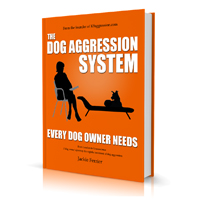Your cart is currently empty!
Does Gut Bacteria Play A Role In Dog Aggression?
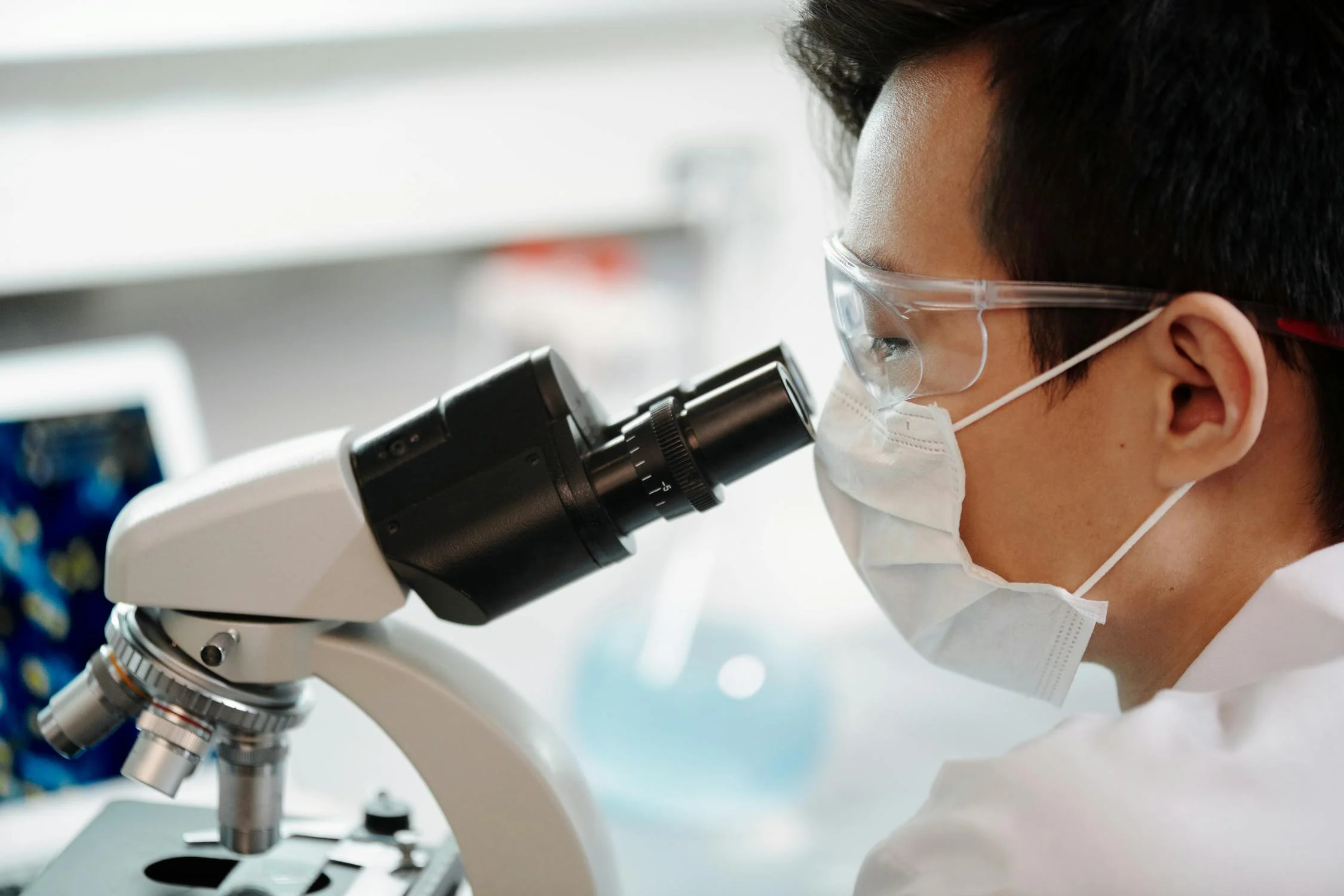
Studies have found that disruptions in the gut microbiome, such as an imbalance in the ratio of beneficial to harmful bacteria, can lead to various health problems, including behavioral issues in dogs. In particular, some research has suggested that alterations in the gut microbiome may contribute to aggression in dogs.
One possible explanation is that imbalances in the gut microbiome can lead to an increase in the production of certain metabolites, such as short-chain fatty acids, that can affect brain function and behavior
Gut Flora and its role in health and disease
The gut microbiome refers to the complex community of microorganisms that inhabit the gastrointestinal tract of animals, including dogs. These microorganisms play important roles in maintaining the health and well-being of their hosts, including regulating the immune system and aiding in the digestion and absorption of nutrients.
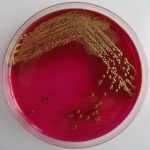
One of the most interesting trends in research today is how gut bacteria influences human health. The role that bacteria plays in keeping us healthy and protecting us from disease is vast and complex. When the balance of this bacteria world in our gut gets upset, it may play an important role in disease development and mental health disorders not just in humans.
Now there may be some evidence that there is link between aggression and the gut microbiome composition (bacteria in the gut).
Pilot Study in Dogs
A pilot study set to find out if there is a link between gut flora and dog aggression toward other dogs. In the study of 31 pitbull dogs, 10 were considered non-aggressive and 21 aggressive toward others in a shelter environment. While this is a small sample size they considered this study important because the dogs were in the same shelter environment. As a result they could control for so many other factors: sameness of environment, same diet, breed, etc. Then they recorded and compared the amounts of different groups of bacteria in the dogs stool samples.
The breeds were considered the same (pitbulls) however we don’t know how they were identified. If they were classified by visual identification only, the similarity in breed may not be as accurate as thought. See more about breed identification here What Breed Is My Dog: How to Really Tell).
The Results

What they found was a significant difference between the amounts of bacteria in the aggressive as compared to the non-aggressive dogs.
Certain bacteria groups were higher in non-aggressive dogs.
- Bacteroides
- Fusobacterium
- Proteobacteria
- Dore
Certain bacteria groups were higher in aggressive dogs:
- Lactobacillus
- Firmicutes
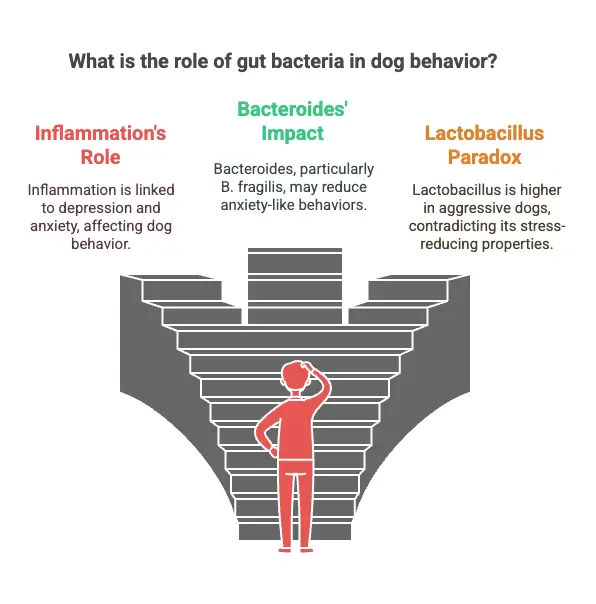
What might these results mean?
Some of these results were as expected. First we know there is evidence that inflammation plays a role in depression and anxiety. Dorea the a type of bacteria found in higher concentration in the non-aggressive dogs is also found in a lower concentration in dogs with inflammatory bowel disease. Also, we can’t rule out that these dogs are suffering from irritable bowel syndrome which influence aggression because of the discomfort.
As well as this, Bacteroides are found in higher concentration in non-aggressive dogs. B. fragilis, a type of bacteria under the Bacteroides group of bacterias has been found in previous studies to treat anxiety-like behaviours in mice (Hsiao, 2013) These facts further indicate a connection between the gut microbiome and psychological behaviours.
However, not all the results of this study matched up with expectations set by previous research. For example, while members of Lactobacillus were found to be higher in the aggressive dogs, previous research, which showed that the specific organism Lactobacillus rhamnosus reduces stress-associated corticosterone levels (the hormone associated with the presence of stress) and anxiety related behavior in mice (Bravo et al., 2011).
While Lactobacillus is a bacterial group with known probiotic and psychobiotic properties, we don’t know yet if the difference in the different members of the bacteria evolving from the same bacterial ancestor is responsible, or whether the interactions of other bacteria play a part in this.
Did you know it is now thought that not only are there are 30 trillion human cells in our bodies, but there are also 38 trillion bacteria cells. We have co-evolved to be mutually beneficial to one another. See more here: Revised Estimates for the Number of Human and Bacteria Cells in the Body
Another study, looked at the gut microbiome of dogs with aggressive, phobic or normal behavior. In this study, dog with aggressive behavioral disorders were found to have a peculiar gut microbiome structure, with high biodiversity and enrichment in generally subdominant bacterial genera (i.e. Catenibacterium and Megamonas). Interestingly we see Lactobacillus, again but this time in the phobic dog segment.
Correlation or Causation?
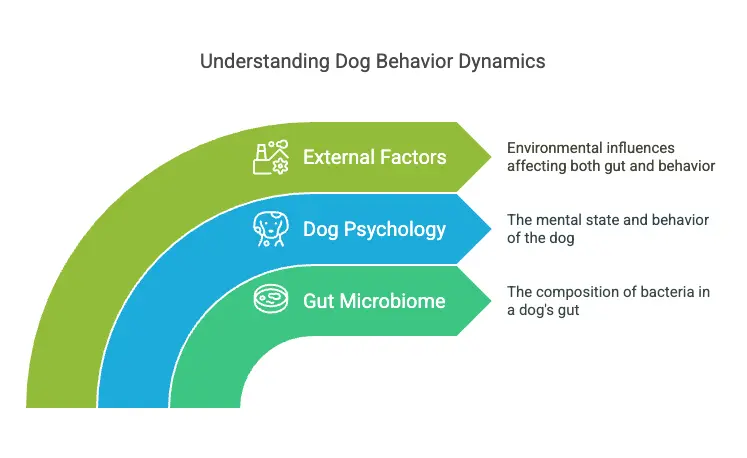
However, while there might be an association, does one necessarily cause the other?In other words, just because there is a we see the abundance of bacteria in one group of dogs, does this mean it has caused the aggression?
Using the finding of this study, we need to look at three main possibilities:
- The composition of bacteria in a dog’s gut can cause or increase the dog’s level of aggressiveness.
- The psychology of the dog is impacting the gut microbiome.
- The gut microbiome composition and the dog’s aggressiveness are related results of outside factors. This can mean that both are related, however, are not a cause of each other.
But what we do know is that there is at least an association, and we are seeing associations between gut bacteria interacting with neurotransmitters, and links between gut biome and affective disorders like anxiety in other species as well.
How bacteria might evolve in its effect
Virus and bacteria evolve and adapt. As they adapt they may cause different kinds and different strengths of symptoms. To complicate things further, as viruses spread from host to host in the same species, it appears that symptoms gradually grow weaker. Could this explain why members of bacteria do not affect each species in the same way?
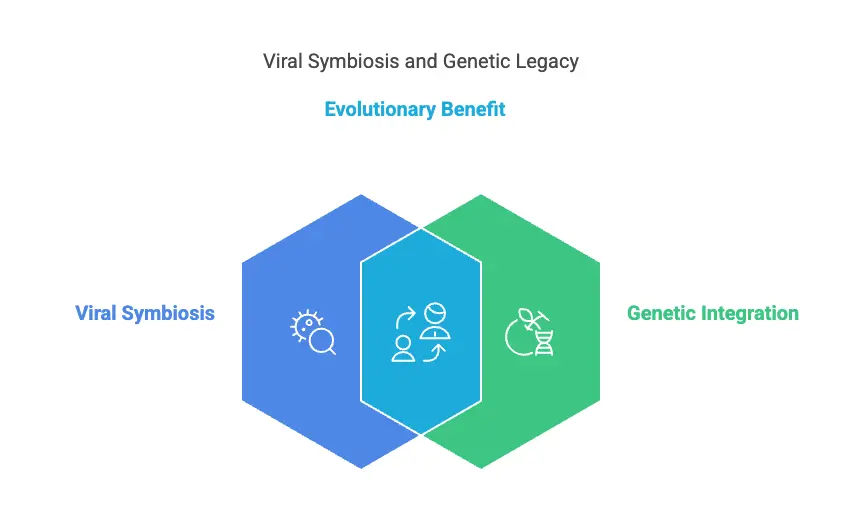
Evidence suggests that viruses create a beneficial relationship with their primary hosts and cause them no ill effects whatsoever. This is called a symbiotic relationship. It is when those viruses cross species, (especially species that are a threat to the host species), the virus attacks the threat species causing them to grow sick or even die. In this way, the virus helps ensure the survival of its host.
As much as 8% of our genome contains genetic elements left over from viruses. (Read more here Endogenous Retroviruses: With Us and against Us )
It is thought that certain bacterias may work the same way. How one bacteria might benefit one species could be different for another species, perhaps depending on how long the species has been host to the bacteria or what other bacteria might be present. Even a particular strain of a bacteria might operate in unexpected ways.
What could this mean to the future?
The role of antibiotics
If the dog’s gut microbiome is causing the aggression, than could it be possible to relieve that aggression using a targeted antibiotic? Or could this result in a larger problem long term?
We know that the frequent use of antibiotics or not taking them as directed accelerates antibiotic resistance in humans. In dogs the most common antibiotic resistant infections show up in the gastrointestinal tract as well as the respiratory, urinary tracts and the skin in dogs. (Read more here: Antibiotic Resistant Bacterial Infections in Dogs).
We also know that antibiotics upsets the balance of microbial balance. Upsetting the microbial balance may cause a whole number of problems, aggression possibly being one of them. (Learn more here Introduction to the human gut microbiota). Therefore the case for using an antibiotic treatment may be difficult to make unless science is able to move in directions that can address these concerns.
The role of diet

Current research is looking at the role prebiotics and probiotics have in restoring natural health. While probiotics may help, we may also need to consider the caring and feeding of these probiotics in the body.
The role of carbohydrates are also under the proverbial microscope. Dogs are omnivores and not carnivores as some might think so are not predisposed to eating all meat diets. Additionally they have evolved with humans, which probably means sharing human food.
However, the way in which food is produced and consumed has changed significantly for both humans and dogs. Commercial dog food itself is relatively a recent phenomenon when we look at the length of time domestic dogs have coexisted with humans.
For example, what impact grains or potatoes found as they are currently being grown and processed in modern dog food could have on a dog’s microbiome for some dogs. What role does the use of antibiotics in meat production have an effect. Perhaps future research may also look to the importance of diet in supporting a balance and healthy microbiome.
We know that dog aggression is complicated and there are a variety of influencing factors, but we may be underestimating how all these things work together or how one may make a dog more predisposed that has another set of factors working against it.
Finally, if the state of gut microbiome suggests a predisposition or a vulnerability for anxiety or aggression, then we might be able to treat aggression before the signs of it are obvious, just by looking at gut composition.
While the exact nature of the relationship between the gut microbiome and dog aggression is still being investigated, the findings suggest that maintaining a healthy gut microbiome through proper diet and other measures may help reduce the risk of aggression and other behavioral problems in dogs. However, more research is needed to fully understand the connection and the best strategies for addressing it.
References:
Clapp, M., Aurora, N., Herrera, L., Bhatia, M., Wilen, E., Wakefield., S. (2017). Gut microbiota’s effect on mental health: The gut-brain axis. Retrieved from https://www.ncbi.nlm.nih.gov
Dodman, N., Brown, D., Serpell, J. (2018). Associations between owner personality and psychological status and the prevalence of canine behavior problems. Retrieved from http://journals.plos.org
Foster, J., Rinaman, L., Cryan, J. (2017). Stress & the gut-brain axis: Regulation by the microbiome. Retrieved from https://www.sciencedirect.com/science/article/pii/S2352289516300509
Hoban, A., Stilling, R., Moloney, G., Moloney, R., Shanahan, F., Dinan, T., Cryan, J., Clarke, G. (2017). Microbial regulation of microRNA expression in the amygdala and prefrontal cortex. Retrieved from https://microbiomejournal.biomedcentral.com
Hsiao, E., McBride, S., Hsien, S., Sharon, G., Hyde, E., McCue, T., Codelli, J., Chow, J., Reisman, S., Petrosino, J., Patterson, P., Mazmanian, S. (2013).Microbiota Modulate Behavioral and Physiological Abnormalities Associated with Neurodevelopmental Disorders. Retrieved from https://www.sciencedirect.com/science/article/pii/S0092867413014736
Kirchoff, N., Udell, M., Sharpton, T. (2018). The gut microbiome correlates with conspecific aggression in a small population of rescued dogs (Canis familiaris). Not peer reviewed – data may be preliminary. Retrieved from http://peerj.com https://peerj.com/preprints/26990/
Meyer, T., Rosenkrantz, J., Carbone, L., Shawn, C. (2017). Endogenous Retroviruses: With Us and against Us. Retrieved from http://www.frontiersin.org
Mudd, A., Berding, K., Wang, M., Donavon, S. (2017). Serum cortisol mediates the relationship between fecal Ruminococcus and brain N-acetylaspartate in the young pig. Retrieved from https://www.ncbi.nlm.nih.gov/pubmed/28703640
Sender, R., Fuchs, S., Milo, R. (2016). Revised Estimates for the Number of Human and Bacteria Cells in the Body. Retrieved from http://journals.plos.org/plosbiology/article?id=10.1371/journal.pbio.1002533
ADVERTISEMENT
The Dog Aggression System Every Dog Owner Needs E-book
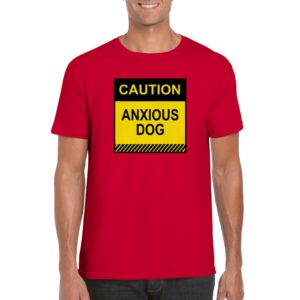
Anxious Dog Shirts only available in our shop

Keep people away with our Stand back shirts
ADVERTISEMENT
ADVERTISEMENT
Tags:

